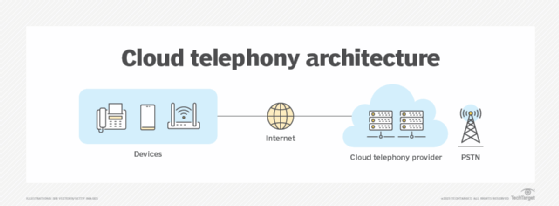
What is telephony?
Telephony is technology associated with interactive communication between two or more physically distant parties using the electronic transmission of data. Long associated with voice communication, telephony has evolved to also include text messaging, video calling, video conferencing, voicemail, call recording and faxing. Telephony provides an efficient and effective means of communication for individuals and businesses.
A telephonic exchange historically required the use of traditional fixed-line telephones, handheld devices containing both transmitters and receivers that connected to local exchange networks using physical wiring. Telephonic communication now uses modern computing and cellular technology, blurring the line between telephony and telecommunication. The definition of telephony and its scope have expanded accordingly.
Internet telephony lets users make calls over Internet Protocol (IP) networks at a much lower cost than using the traditional public switched telephone network (PSTN). Computer apps called softphones behave like legacy telephones but without the need for standalone devices. IP telephony software can reside on a variety of computing hosts, including PCs, laptops, smart desk phones, smartphones and tablets.
How telephony works
How telephony works depends on the form implemented:
- Traditional telephony. Traditional telephone systems convert sound waves at one end of a call into electrical signals that travel to their destination via the wires and cables of the PSTN -- the circuit-switched telephone network that crisscrosses the globe. The recipient's phone converts the transmission back into analog sound signals, enabling a real-time conversation. Also known as the plain old telephone service (POTS), the PSTN is operated by international, national, regional and local service providers. Its underlying infrastructure originally featured copper phone lines but now includes fiber optic cabling, cellular technology and satellite systems. Traditional voice phone service is linked using landlines that connect from the local telephone company office to the customer's premises.
- Mobile telephony. Using cellular technology, a mobile phone converts sound into electronic signals that it broadcasts via radio waves to a local cell tower. The cellular network uses radio signaling to forward this information to the recipient's mobile device, such as a smartphone, which, in turn, converts the signals into sound.
- Internet telephony. Internet telephony software converts sound waves into data that travels over packet-switched computer networks, enabling voice calls to occur online, independent of the PSTN and cellular systems. Voice over Internet Protocol (VoIP) is a Layer 3 protocol and subset of IP telephony. It delivers voice and other communication services, such as video conferencing and text messaging, across broadband and private IP networks. VoIP and IP voice data telephony are similar forms of telephony, and the two terms often are used interchangeably. However, some experts argue that VoIP refers to sending voice traffic as data packets over an IP network, while IP telephony is a broader term referring to any telephone-type communication service carried over IP that connects to IP phones or similar devices.
- Faxing. Legacy fax, which is short for facsimile, technology is similar to traditional voice phone telephony service. Instead of using sound waves as the mechanism for converting data, a fax machine's sensor encodes a printed document, which it interprets as a two-dimensional, fixed bitmap. The machine then converts that graphic into electronic signals. Those signals traverse the telephone network and arrive at the receiving fax machine, which reconverts and decodes the signals, reassembling and printing them to reflect the original document. IP faxing, also known as fax over IP or virtual faxing, functions much like traditional faxing but via the internet. Software encodes a scanned document and converts it into data that travels over local and wide area IP networks before being decoded and reconverted on the receiving end.
- Contact centers. When it is necessary to handle many incoming calls for business purposes, a specialized system called a contact center or a call center is used. While systems today are largely IP-based and often delivered by cloud services, older generations of contact centers used electronic switching systems without IP connectivity. Today's contact centers either have agents in a single physical location or have them geographically dispersed using a cloud- or IP-based contact centers. Agents often work from home and have connectivity to customer relationship management systems that facilitate interactions with customers.
Benefits of telephony
Telephony provides the following benefits:
- Low-cost calling and messaging.
- Connectivity almost anywhere in the world.
- Voice over IP services that provide connectivity to anyone with a phone number -- the VoIP phone call recipient doesn't require special equipment.
- Increased accessibility, as telephony systems are available in multiple forms, such as text messaging, video conferencing, voicemail and faxing.
- Added mobility using tools such as softphones and smartphones.
- Ubiquity of service that provides advanced communications features and services to users.
Challenges of telephony
Some downsides associated with telephony, however, include the following:
- It requires a reliable internet connection.
- Not all VoIP systems connect directly to emergency services.
- Call quality is susceptible to network jitter and latency due to insufficient bandwidth.
- Emergency calling services, such as Enhanced 911, might be limited in remote locations.
Types of telephony systems for the enterprise
There are five ways larger companies use telephony technology.
Legacy, circuit-switched PBX
In traditional phone systems, on-premises private branch exchanges (PBXs) act as in-house switching centers, connecting calls between internal devices and routing external calls to and from the PSTN via dedicated trunk lines. Human operators managed the earliest PBX systems, but eventually, automated attendants replaced them. Operators are still employed in specific applications, like hospitals and hotels, where a personal touch and specific expertise are needed. Expensive, complex and now mostly obsolete legacy non-IP PBX systems were historically used by businesses of all sizes with great success.
This article is part of
Ultimate guide on enterprise unified communications strategy
Key PBX systems
Smaller businesses and remote corporate offices use so-called key systems that are designed for smaller requirements yet can be connected to larger PBX and IP PBX systems. Considering how important uninterrupted power is for PBX and IP PBX systems, a key feature called power failure transfer automatically connects specific phones to POTS lines that continue to work even in the event of power outages.
VoIP PBX
Like the traditional PBX, a VoIP or IP PBX creates a private phone network within a business but does so via the internet or a private local area network rather than dedicated voice circuits. It's often deployed on a subnet that's configured within the existing internal network specifically for IP traffic.
Because it doesn't rely on the PSTN, internet telephony can be more cost-effective than legacy technology. This depends on the system configuration; features used; special systems, such as contact centers; cost for internet access; and cost for IP device licenses.
On-premises IP PBX telephony systems consist of software running on servers, a network infrastructure, IP station sets and power systems. An on-site IP PBX typically offers more sophisticated feature sets and greater reliability than a legacy PBX system. Cloud-based VoIP service, which can be a suitable alternative, needs internet access where an IP handset is installed. On-site installations are more complex to maintain and can be more expensive per station than cloud-based systems.
Hybrid PBX
Some organizations deploy a hybrid PBX model that uses both legacy and IP telephony technology for redundancy, cost savings or a staged migration to VoIP. These environments use gateways to bridge VoIP and PSTN functionality. Alternatively, a hybrid PBX approach can refer to a VoIP telephony system with both on-premises and cloud-hosted resources.
Cloud VoIP
Cloud VoIP, also known as cloud telephony, is a third-party VoIP service provided by managed service providers and cloud vendors experienced in IP telephony and unified communications-as-a-service offerings. Outsourcing lets enterprises eliminate the need to provision, manage and maintain an on-site IP PBX, reduce infrastructure costs and increase scalability. Comparison of features, functionality and management controls is essential when deciding which type of telephony to use, along with costs for software licenses, network services and maintenance.

Key telephony use cases
There are a range of potential individual and business use cases for telephony technologies. For example, telephony is used for text messages, voice calls, video calls, business conferences and voicemails, as well as faxes.
Other use cases of telephony systems include the following:
- International calls.
- Document transfer.
- Video and audio business meetings.
- Communication software integrated with other business tools.
- Group and team messaging.
- Contact centers.
- Interactive voice response.
- Automated attendants.
History of telephony
The word telephony comes from the Greek root word tele, which means far, and phone, which means speak. In 1876, Alexander Graham Bell patented the telephone to electronically transmit human speech, building on the success of the telegraph system. Bell's main competitor at the time, Elisha Gray, was also developing a telephone device but arrived too late at the patent office to register his patent. Bell arrived earlier and obtained the golden patent, which is considered one of the most significant patents in history.
A few days later, Bell spoke the first words ever communicated via telephone to his assistant, Thomas Watson, who was in the next room: "Mr. Watson, come here. I want to see you." The following year, he made the first long-distance phone call in history -- from Salem, Mass., to Boston -- and subsequently founded Bell Telephone Company, which would later become part of AT&T.
The earliest telephones came in pairs, with each line directly connecting just two locations. This was impractical, however, because users needed a separate wired device for each contact they wished to call. Soon, the invention of the telephone exchange enabled users to communicate with any other local party wired for service with the help of a switchboard operator. Trunk lines connected individual telephone exchanges, enabling calls to take place over increasingly significant distances.
AT&T began planning a cross-country telephone line in 1908, eventually laying 3,400 miles of copper wiring from coast to coast. Engineers used innovative loading coils and vacuum tubes to amplify electrical signals as they made their way across the country.
Thirty-nine years after filing his patent, Bell inaugurated the transcontinental telephone service with a ceremonial call from New York to San Francisco. He repeated his now-famous words: "Mr. Watson, come here. I want to see you." Watson replied from California: "It will take me five days to get there now." President Woodrow Wilson and AT&T President Theodore Vail joined them on the call.
The major milestones in the history of telephony include the following:
- 1876. Bell patents the telephone and makes the first telephone call.
- 1877. Bell makes the first long-distance call from Salem, Mass., to Boston.
- 1889. Almon Strowger, an undertaker by profession, invents the first automatic telephone switch, typically called the step-by-step switch.
- 1908. AT&T starts planning cross-country telephone service.
- 1915. Bell makes the first transcontinental phone call from New York to San Francisco as part of the Panama-Pacific International Exposition.
- 1956. The first submarine transatlantic telephone cable system is launched between Europe and North America.
- 1965. AT&T deploys the first all-electronic telephone switch, located in a New Jersey Bell Telephone Company central office in Succasunna, N.J., enabling advanced features, such as call waiting.
- 1969. The Advanced Research Projects Agency Network, an experimental predecessor of the internet, comes to fruition with the successful interconnection of four university computers.
- 1973. Computer scientist Danny Cohen pioneers Network Voice Protocol, the forerunner to VoIP, at the University of Southern California.
- 1983. Motorola debuts the first commercially available mobile phone. Nicknamed The Brick, the DynaTAC weighed two pounds, took 10 hours to charge and sold for $3,995 each.
- 1994. Smartphones become available to the public with the launch of IBM's Simon Personal Communicator.
- 1995. VocalTec releases Internet Phone, considered the first commercially available VoIP service.
- 1999. The Internet Engineering Task Force standardizes Session Initiation Protocol, a key network protocol underlying many online telecommunication services in use today.
- 2003. Skype launches its revolutionary free VoIP service, later adding video functionality.
- 2011. Google debuts the open source Web Real-Time Communications project, enabling voice and video communication across standard web browsers without the use of plugins.
- 2020. The COVID-19 pandemic forces businesses that relied on on-premises infrastructure to rethink their communication strategies when employees start working remotely. Many businesses began using telephony tools, such as Zoom or Microsoft Teams, which provided video calling, collaboration, call recording and file sharing.
- 2024. The rivalry between Zoom and Microsoft Teams continues, as many organizations provide their employees with a flexible hybrid work environment where they work partly in the office and partly remote.
IP telephony and VoIP are similar technologies. Learn more about each and the differences between them.







